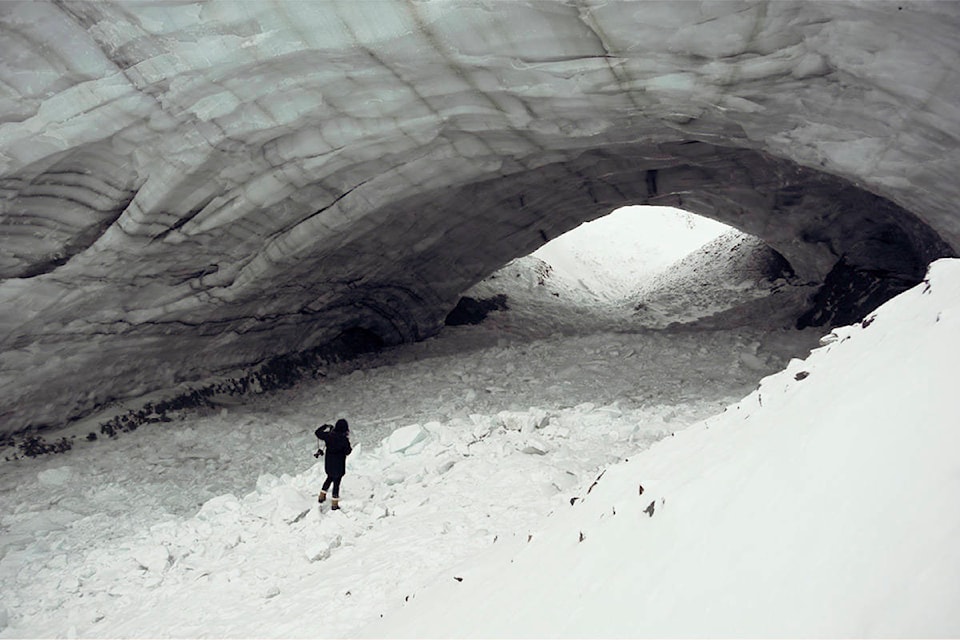It’s a popular natural wonder dating back to the last mini-ice age, one that’s just a stone’s throw from Haines Junction.
It’s remaining lifespan may be on the shorter end though, so experts are encouraging Yukoners to visit the Kluane ice cave while they still can — just don’t go inside.
A roughly 13-kilometer drive north of Haines Junction followed by a relatively tame seven-kilometer-or-so hike off the Alaska Highway up a frozen creek bed, the cave has long been a source of local intrigue but has exploded in popularity in recent years.
(It’s become so popular, in fact, that this year, a pull-out has been created for vehicles near the trailhead. Previously, intrepid explorers would have to park their vehicles on the shoulder of the highway).
The Yukon Geological Survey’s head surficial geologist, Jeff Bond, said the cave likely began forming during the last little ice age — a period roughly between 1400 and 1900 — when glaciers covered more of the global landscape.
“There’s quite often subglacial drainage under glaciers … Surface waters on glaciers often find their way to the base of the glacier because of the crevasses,” Bond explained in an interview Jan. 21.
“And so the surface water will ultimately want to drain sort of along the base of the glacier and you’ll get tunnels forming where the water’s been flowing.”
As glaciers recede, they occasionally leave behind little pieces of themselves behind across their former domains. These ice chunks can take decades, if not centuries, to melt away thanks to insulatives layers of rock and debris surrounding them, leaving behind temporary, albeit long-standing, features on the landscape.
In the Kluane ice cave’s case, the little tunnel carved by meltwater has gradually grown larger overtime, and at this point, while there may be a stream that runs along its floor in the summer, the growth of the space is now primarily triggered by the ice melting in the warmer months.
“This time of year, obviously, you’re not going to see much change but after a full summer of melt, especially on the, we noticed, on the valley side … that’s the side that gets the evening or afternoon sunshine,” Bond said. “…It seemed to me like the most melt was happening at that far side in terms of the amount of water that was dripping down, it was really raining down on the upvalley side.”
Bond’s observations came from a Yukon Geological Survey staff trip to the cave last winter, which included flying a drone through the cavern and hiking up and around it to get a better idea of its makeup and structural integrity.
“We confirmed that there is active, you know, ablation, I guess you might say, occurring inside the cave, which means that there’s melting and blocks of ice peeling off,” he said, adding that rock and other debris is also tumbling off the top or sides of the cave.
The discovery prompted the organization to issue a warning for hikers to not enter the cave, which, in its current state, is estimated to collapse within the next five years or so.
Besides the crumbling, staff also documented one of the cave’s most striking features — the dark stripes breaking up its otherwise blue-ish facade.
They’re layers of debris that were either compressed in between the layers of snowpack that formed the glacier, or were picked up as the glacier moved, Bond said.
The fact that the debris layers were somewhat deformed was particularly intriguing for staff.
“I think (the striping) just gives you some idea of the forces of the ice and how these things can get compressed and almost contorted, these layers, because they typically should be pretty flat-lying but they’re not,” he said. “When you look at the ice there, they’re almost vertical.”
Glacial ice caves, in general, aren’t a particularly rare phenomenon — they form periodically around most glaciers, Bond said, but often collapse before they’re discovered, if they get discovered at all.
“It’s just the circumstances here were kind of just right,” Bond said of the Kluane ice cave and its allure. “It’s close to the road, it’s within easy hiking distance, that’s the main reason it’s getting a lot of attention and people should go out there an see it, it’s a great feature to go and check out.”
Contact Jackie Hong at jackie.hong@yukon-news.com
